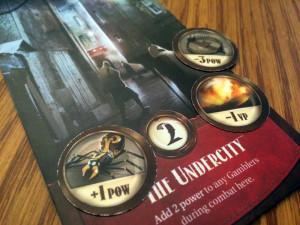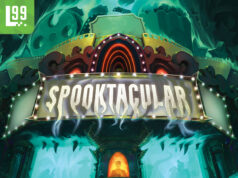Note: This preview uses pre-release components and rules. What you see here may be different from the final, published game.
 After I got the chance to preview Strife: Legacy of the Eternals from V3G games, I knew it would be a game that, if successful, could spawn a few sequels using a different genre. I guess the brain trust at V3G agreed with me and they have a kickstarter that has already reached funding for Strife: Shadows and Steam.
After I got the chance to preview Strife: Legacy of the Eternals from V3G games, I knew it would be a game that, if successful, could spawn a few sequels using a different genre. I guess the brain trust at V3G agreed with me and they have a kickstarter that has already reached funding for Strife: Shadows and Steam.
I really enjoyed the first game in this series of heavy strategy games for only two players. It is a game that just keeps getting better the more you play. Shadows and Steam takes the same core mechanics from the first game and adds a few new wrinkles to the rules all in a new steampunk universe with its own unique champions. Because this game can be played as both a standalone and expansion, I will be doing this preview a little differently. I will first explain the game in full for people who haven’t played the game before and then talk about what is new to the game. Let’s get to it.
Game Overview:
Each player starts a round with the same hand of ten champions and will play them simultaneously each turn as they fight at different locations around the world. The player whose champion has the highest power value after the fight wins the victory points available at that location. The champion’s power value range from zero to nine with each card only placed from your hand once per round.
These champions have more than just their power value to consider when selecting them for battle. Each card has a battle ability that will affect the current battle as well as a legacy power that will affect the next champion the player plays from their hand. Players will have to manage the order that they play their cards to unleash some very powerful combos to defeat your opponent by having the most victory points at the end of three rounds of play.
How to Play:

At the start of the game each player takes one set of the identical steampunk inspired champion decks. Three location cards are drawn and placed face up on the table with the one farthest away from the deck being the current location. Each location not only awards the number of victory points to the winner of the battle, but also bonuses to specific champion’s power level if they are played at this location.
During the first turn, players will place two champions on the table. One at the current location card and one into the Legacy pile. The Legacy pile is where all champions go after they battle and the card on top of this pile will have its legacy ability activated. The last thing involved with setup is deciding who starts with the Fatestone die.
This die is used to break ties that occur during the game. Anytime there is a tie, the player currently holding the Fatestone loses if they do not pass the die to the other player. If they decide to pass the die, they win that conflict and claim the victory points or allow their power to activate first, pass the die to the other player, and finally increase the value of the die by one. The catch is that the player that holds this die at the end of the game earns the number of victory points equal to the Fatestone’s final value. At the start of the game, the player who played the highest power value card into their Legacy pile will gain the die, with ties broken by battle champion’s power level and then die rolls if necessary.
Each turn following the setup will consist of five phases:
1. Selecting a Champion: Players will choose a champion from their hand and place it face down next to the current location.
2. Battle phase: The champion with the highest printed power level activates their battle ability first.
3. Legacy Phase: The legacy champion on top of the Legacy pile with the highest power level activates its ability before the other champion’s legacy power.
4. Combat Phase: Players will add up the total power for their current battle champions and the player with the highest total wins and gains any effects and/or victory points. If there’s a tie, use the Fatestone rules as described above.
5. Clean-up Phase: Players will place their current champion card on the legacy pile. They will also remove the current location and draw a new location.
This will continue until each player is down to one champion left to play, or there are no locations left. The player with the most victory points at the end of three rounds wins the game.
What’s New:
The major change to the rules is the addition of tokens to the game. These tokens are placed using a champions battle or legacy ability onto one of the three face up location cards on the table. There are three of them in the game which affect the amount of power for you or your opponent have at that location or the number of victory points a location is worth.
There is an optional rule set for cross-set play between Shadows and Steam and Legacy of the Eternals games. Each player will choose a set of 10 champions from each game and five locations from that have a total value of 11VP.

Game Experience:
Strife is a game of perfect information. At all times players know what locations are possible this turn, what the player has left in their hand and their current legacy power. The only unknown element of the game is what card your opponent will end up playing. This allows for a game that has players racking their brains looking over their hands for the best options on their turn while still considering what you opponent could play.
The gameplay is very easy to teach using the starter game version in the rulebook. This strips away some of the powers and allows people to understand the basic mechanics without throwing them into the deep end of this strategy game. With new players you are definitely going to want to do this. Once you are used to that you can get into the meat of the game.

What allows this game shine is the battle and legacy powers. Without the combo creation element, the game would be boring and repetitive. When I started to read over the different powers I was excited by the possibilities of playing certain cards in succession and defeating my opponent’s champion. Even though the powers are quite varied in their effects, they all are very well balanced. They allow for each champion to have a decent chance of winning a battle regardless of their power level.
The major issue with this game is that it has a steep learning curve. The element that makes it a great game requires a few games under your belt to fully understand the how all the different sets of powers interact with each other. When I play this game with a person who has never played, I will tend to do better because I understand the nuances. There is a point where this gets to a level playing field, but it can be discouraging and frustrating for new players. It just forces players to spend the time to fully understand how all the cards interact with one another. When both players get to this point it turns the game into the strategy powerhouse that it is.
Another issue I found was when you have a full hand of ten cards to decide you strategy at the start of a round, analysis paralysis can affect players. However, after each player has played a few turns, the game will go much faster. Both of these negatives end up going away the more and more you play the game.
While the element of perfect information leads to a highly strategic game, it doesn’t lead to any customization for the players. You are forced to play with these ten champions and them alone. I don’t mind this, but it was something brought up while playing. One way to spice up the game is already in the box and that is an optional variant using Event cards. These add an ability that is persistent for the entire game round. Some are better than others, but this allows for a new wrinkle of additional planning for the players.
Another unique element about the game is the Fatestone. As I read through the rule book I was surprised to see the purpose for the die they had in the box. Instead of being rolled to break ties and adding randomness to the game, it instead gives the power to the player holding it to decide their fate. It leads to some interesting decisions for you to make later in the game. You could lose a location to another player, but still want to hold on the die to keep those precious victory points it is granting. It’s a simple mechanic, but adds another layer of strategy to the game.
What’s New:

Shadows and Steam doesn’t just take the same powers from the first game and slap a new champion on the card. Instead the powers are completely unique. The game feels like a completely different set of decisions and interactions that you are able to craft while playing. I do feel that that powers in this game are a tad bit more complex than in the first game in the series. This isn’t a detriment the the game overall but it might take a little more time to get players comfortable with how the cards interact. Despite that, I think it’s the better set of champions then in the first game because of that added complexity.
Since the mechanics of the first game worked so well I’m glad they didn’t abandon them for something new. Rather the addition of the tokens in the game adds another layer of strategy. This is achieved by being able to place the tokens on any face-up location and allows players to potentially manipulate a round of play two rounds ahead of time. If you could only play on the current location, the mechanic would be mostly pointless in my opinion, however it is implemented quite well into the game. There are only a few champions that can place a token during the game and this keeps the tokens from overrunning the table. This new mechanic adds just enough to the game without overstaying its welcome.
The last new thing is the cross-set play and this works fine. Players will have to be well versed in the powers of both sets to fully enjoy the experience. I do think this adds a nice amount of variety to the game to keep it interesting. I have to admit I was hoping for something a little more than just each player taking a full set from the two games. When I first saw the rule I thought about mixing champions from each set together, but the differences in the powers between the two sets could create some wild combos that would take the fun out of the game.
Final Thoughts:

Strife: Shadows and Steam is a worthy successor to Strife: Legacy of the Eternals. It doesn’t reinvent the wheel in terms of mechanics but it does a nice job building off the first game in the series.
The addition of new champion powers, tokens, and cross-set play gives this game just enough new things to intrigue seasoned and new players. Strife: Shadows and Steam is a simple game at its core with minimal number of cards and rules to play. However, there are layers of deep strategy to Strife as you see the combinations you can make with the battle and legacy powers. Strife is a game full of difficult decisions for the players to make and the game keeps getting better the more you play.
If you’d like to become a backer, pledges start at $15 for the full game and stretch goals. Strife: Shadows and Steam is scheduled to be in backers hands in April of 2016 and you have until Tuesday, February 23rd to become a backer. Head over today and check it out.
As always, we don’t post ratings for preview copies as the components and rules may change from the final game. Check back with us after the game is produced for a full review.






















Sounds pretty cool. Thanks for the preview, Tyler!